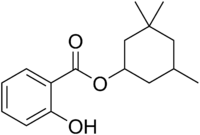Homosalate
 | |
 | |
| Names | |
|---|---|
| IUPAC name
3,3,5-Trimethylcyclohexyl 2-hydroxybenzoate | |
| Other names
Homosalate | |
| Identifiers | |
| 118-56-9 | |
| 3D model (Jmol) | Interactive image |
| ChemSpider | 8059 |
| ECHA InfoCard | 100.003.874 |
| KEGG | D04450 |
| PubChem | 8362 |
| UNII | V06SV4M95S |
| |
| |
| Properties | |
| C16H22O3 | |
| Molar mass | 262.36 g/mol |
| Density | 1.045 g/cm3 |
| Melting point | <25 °C |
| Boiling point | 161 to 165 °C (322 to 329 °F; 434 to 438 K) at 4 mmHg |
| Except where otherwise noted, data are given for materials in their standard state (at 25 °C [77 °F], 100 kPa). | |
| | |
| Infobox references | |
Homosalate is an organic compound used in some sunscreens. It is an ester formed from salicylic acid and 3,3,5-trimethylcyclohexanol, a derivative of cyclohexanol. Contained in 45% of U.S. sunscreens, it is used as a chemical UV filter.[2] The salicylic acid portion of the molecule absorbs ultraviolet rays with a wavelength from 295 nm to 315 nm, protecting the skin from sun damage. The hydrophobic cyclohexanol portion provides greasiness that prevents it from dissolving in water.
Safety
Similar to other UV filter compounds,[3] more homosalate is absorbed into the stratum corneum of the face (25% of applied dose) versus back of volunteers.[4] Homosalate has been identified as an antiandrogen in vitro,[5] as well as having estrogenic activity toward estrogen receptors α,[6] and general in vitro estrogenic activity.[7] Homosalate has been shown to be an antagonist toward androgen and estrogen receptors in vitro.[8] There is also heavy evidence that homosalate, (and other UV filters) can break down into more toxic products.[9]
No evidence of toxicity or side effects have been documented in vivo.
References
- ↑ Homosalate, Merck Index, 11th Edition, 4660
- ↑ Homosalate, ChemIDplus
- ↑ Rougier A, Dupuis D, Lotte C, Roguet R, Wester RC, Maibach HI (1986). "Regional variation in percutaneous absorption in man: measurement by the stripping method". Arch. Dermatol. Res. 278 (6): 465–9. doi:10.1007/bf00455165. PMID 3789805.
- ↑ Benson et al., 2005
- ↑ Ma et al., 2003
- ↑ Gomez et al., 2005
- ↑ Schlumpf et al., 2004
- ↑ Schreurs et al., 2005
- ↑ Klimova et al., 2013. Current problems in the use of organic UV filters to protect skin from excessive sun exposure. Acta Chimica Slovaca, 6(1):82—88, doi:10.2478/acs-2013-0014